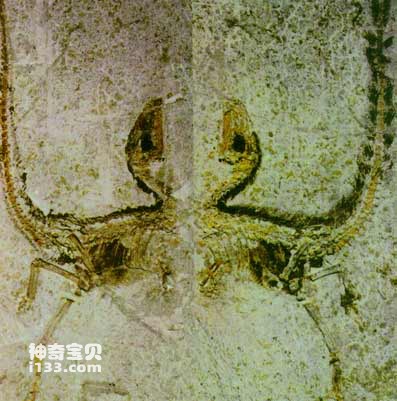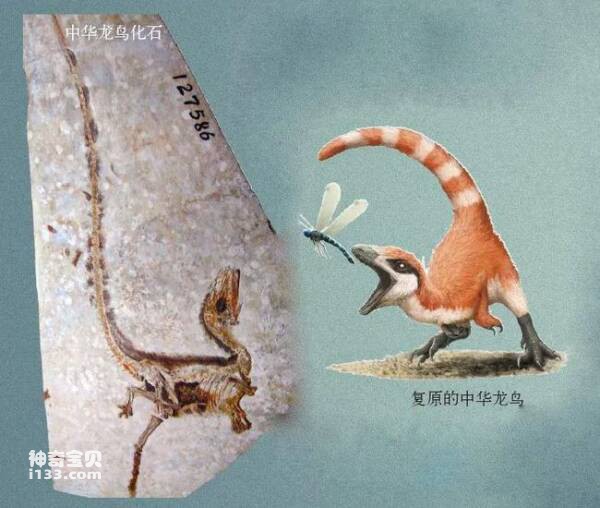From the end of 1996 to the beginning of 1997, many news media around the world rushed to report on the "most primitive bird" - Sinosaurus unearthed in Sihetun, Beipiao City, Liaoning Province, China. Researcher Ji Qiang, a researcher of Sinosauropteryx and director of the China Geological Museum, pointed out that this "feathered" fossil is the true ancestor of birds, and its age is the late Jurassic. Its characteristics prove that birds are Evolved from dinosaurs.

Sinosauropteryx fossil
However, almost at the same time, on October 17, 1996, the New York Times published that researcher Chen Piji of the Nanjing Institute of Geology and Paleontology, Chinese Academy of Sciences, announced at the 56th annual meeting of the North American Society of Vertebrate Paleontology that a bird also produced in Sihe The photos of "Feathered Dinosaurs" in Tuen aroused great interest among the participants.
The above-mentioned reports caused a sensation in the international paleontological community. Many scientists have commented one after another and launched a heated discussion on the age and taxonomic status of Sinosauropteryx.
After research and verification, the "Chinese dragon bird" and the "feathered dinosaur" are indeed from Sihetun, Beipiao, Liaoning. The fossils are all produced in a 2 to 7-meter-thick layer of shale deposited by lakes containing volcanic ash. This layer of shale is located in a large set of thick layers in the entire formation, which geologists call the Jehol Group. The lower part of the group's strata. Moreover, the "feathered dinosaur" is actually the holotype of the fossil specimen of "Sinosaurus", and the two are the same individual of a certain animal. It was originally excavated by a farmer in Sihetun, and was divided into two pieces (positive type and negative type) from the middle of the fossil along the layering of the rock strata. Subsequently, the positive model was obtained by researcher Chen Piji, and the negative model was obtained by researcher Ji Qiang.

Research has proven that the morphological characteristics and body size of Sinosaurus are similar to Compsognathus, a small theropod dinosaur from Germany, and they can be classified into the same category. Sinosauropteryx is a bipedal animal, and adults can grow up to 2 meters long. On its back, there is a row of epidermal derivatives similar to "hair". Some paleontologists believe that these are primitive "feathers", so Sinosauropteryx should be a primitive bird; other paleontologists believe that this skin derivative does not have the characteristics of feathers, but is similar to modern birds. The epidermal derivative structure on the back of some living reptiles (such as lizards) - horny setae, which may also be fibrous tissue.
Judging from the fossil bones, Sinosauropteryx has many typical dinosaur characteristics: its skull is low and long, and its braincase (anatomically called the cranium) is very small; it has obvious post-orbital bones behind its eye sockets, "chin" "The square bone at the back (anatomically called the mandible) is straight; its teeth are flattened on the sides, looking like knives, and have a zigzag structure on the edges; the pubic bone in its waist and hip bones (anatomically called the girdle) is thick , extending forward; its tail is quite long, with more than 60 tail vertebrae, and there are well-developed neural spines and vein arc structures on the tail vertebrae; its forelimbs are particularly short, only one-third of the length of its hind limbs. The characteristics of the forelimbs Showing that it lived later than the German Compsognathus. Chen Piji and other researchers published a research paper in the British magazine Nature on January 8, 1998, arguing that Sinosaurus was a small theropod dinosaur. Of course, according to the biological nomenclature rules, the name "Chinese Dragon Bird" originally given to it by Ji Qiang is still used.
Paleontologists have discussed the function of the hair-like epidermal derivatives on Sinosaurus. Some believe it may be a "decoration" to indicate gender; others believe it is a thermal insulation device. The latter explanation seems to be more reasonable, because small dinosaurs and small Archaeopteryx should have high metabolic rates for efficient activities, and therefore need to maintain body temperature. It can be deduced from this that the hair-like epidermal derivatives on Sinosaurus indicate that small dinosaurs may be warm-blooded animals (that is, endothermic animals). Some paleontologists speculate that this kind of "hair" is the precursor of feather evolution, so they call it "prefeathers". Currently, paleontologists are still using new methods to conduct further research on it.
Interestingly, in the fossil skeleton of Sinosauropteryx, a small lizard fossil was found in its abdominal cavity. Apparently, this lizard was prey captured and swallowed by Sinosauropteryx.
As for the age of Sinosauropteryx, based on recent in-depth studies of the strata from which it was produced, scientists have basically determined it to be the early Cretaceous period, about 130 million years ago.
animal tags:
We created this article in conjunction with AI technology, then made sure it was fact-checked and edited by a Animals Top editor.